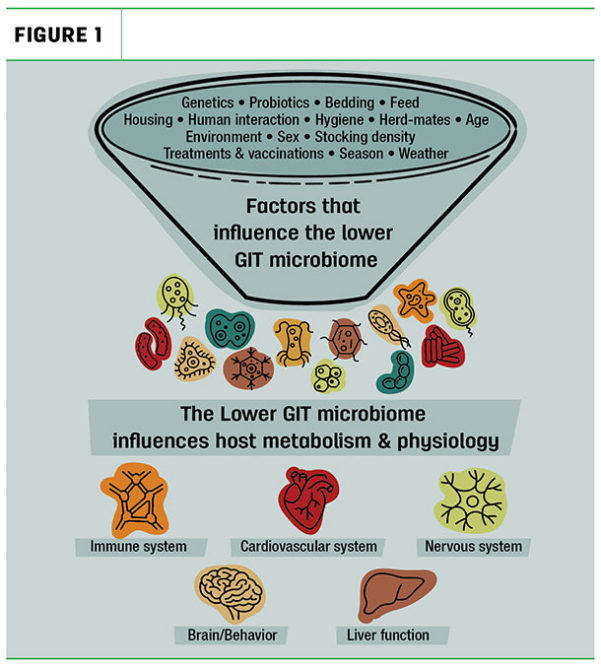The idea of the gut microbiome having an impact on health is not new. Hippocrates (400 B.C.) stated that, “Death is in the bowels, poor digestion is the origin of all evil.”
For many people, when the terms “beneficial bacteria” or “microbiome” are used in the same sentence as “cow,” their first thoughts focus on “rumen bugs,” “rumen health” and “nutrition.” The link between rumen health and animal performance has been well established, and nutritional strategies aimed at promoting rumen health have been beneficial for overall health and performance in cattle. Nutritional strategies that extend their focus into the microbiome of the lower gastrointestinal tract (GIT) represent a window of opportunity for further improvement of animal health.
A microbiome is a community of individual microorganisms sharing a habitat. While we often think of the microbiome as part of the GIT, there are the additional microbiomes of skin, lungs, ears, eyes, mouth and reproductive organs that are being studied to understand their relevance to, and impact on, health of the host.
While bacteria represent the largest fraction of biomass in a microbiome, there are also viruses, fungi, yeast and other microbial organisms that make up a microbiome. So how does all this tie back to herd health and animal performance? The microbiome of the small intestine interacts with more than 70% of the immune system of the host; therefore, supporting a healthy microbiome helps support a normal, healthy and balanced immune system.
In the ideal situation, the microbiome is in a state of homeostasis, which means beneficial microbes can keep pathogenic and inflammatory microbes in check. When the microbiome is out of balance (dysbiosis), we observe negative effects on fiber digestion and fermentation, vitamin synthesis, and regulation of inflammatory responses. The low-grade inflammation that occurs in the lower GIT is commonly referred to as “leaky gut.” This inflammation has been associated with diseases across all tissues and organs of animals.
There are many factors that influence the microbiome from before the calf is born until she leaves the herd. These can include, but are not limited to, husbandry, host, environment and human factors. While some factors that influence the microbiome cannot be altered easily due to genetic background or geographical climate, we can focus on some management and nutritional strategies that can impact GIT development and health (Figure 1).
Establishing a healthy microbiome and a healthy lactating cow begins at birth. The initial colonization of the ruminant GIT is derived from the environment, maternal feces, saliva, skin and vaginal canal, while on-farm practices (e.g., housing, contact with dam, diet, etc.) contribute to GIT microbial establishment. This is one of the many reasons why hygiene of the maternity pen and early administration of colostrum are so important.
Bifidobacterium, faecalibacterium and lactobacillus are of great importance to the young ruminant, as they aid in GIT development and have demonstrated their effectiveness as probiotics. Feeding pasteurized colostrum, compared to fresh colostrum or no colostrum, increases the relative abundance of bifidobacterium and decreases the colonization of E. coli in the small intestine.
Another beneficial microbe is faecalibacterium, which is known to produce butyrate, a volatile fatty acid that promotes ruminal and intestinal development. Butyrate enhances gut barrier function through the pre-weaning and weaning period by increasing expression of tight junction protein-related genes, thus reducing the risk of “leaky gut.”
Lactic acid bacteria and bacillus species are commonly found in probiotics. These bacteria target the small intestine, help stabilize the microbiome of the entire GIT and support calf health by decreasing the risk of colonization by pathogens. They do this through different modes of action. One mode is by producing antimicrobial compounds leading to direct inhibition of pathogens, while another mode is more indirect – by simply taking up space on the mucosal surface and not allowing pathogens to bind (competitive exclusion).
A third mode of action is supporting barrier function. Lactobacillus animalis, a common probiotic strain, has been shown to be effective at maintaining gut-barrier function during a salmonella Dublin, Heidelberg, Newport or typhimurium challenge. As the ruminant ages, diet and GIT development are key contributors to changes in GIT bacterial communities. Daily feeding of a science-based, research-proven probiotic during the pre-weaning and developmental stages of replacement heifers has been associated with enhanced intestinal health and development, leading to a healthier, more efficient animal entering the lactating herd.
Maintaining a balanced microbiome by daily feeding a proven probiotic becomes even more important as the animal reaches the lactating herd and experiences more daily stressors. Maintaining a healthy, balanced microbiome in the rumen is essential for starch and fiber digestion, as well as regulating pH and oxygen scavenging, and reducing the risk of sub-acute ruminal acidosis. However, the benefits, especially toward cow health, increase if we continue to focus on the microbiome beyond just the rumen.
Most microbes flowing from the rumen into the abomasum are lysed by the low pH and enzymatic activity. This leads to a substantial decrease in microbial numbers and diversity by several orders of magnitude. Therefore, for a probiotic to have an effect in the small intestine, it must first be able to survive these harsh conditions. This is where strain selection, a first step in probiotic development, becomes very important. Within a species of bacteria, there can be thousands of different strains all with unique genetic identities and distinctive morphological, biochemical and behavioral features. The bacteria strain must be able to survive the harsh conditions of the ruminant GIT and confer a benefit to the host.
Currently, there are two classes of probiotics available commercially for animals: lactic acid bacteria (LAB) and bacillus bacteria. The well-documented modes of action and life cycles of these two types of bacteria make them great candidates for consideration. LAB have a triangular effect on microbiome modulation by enhancing epithelial barrier function (reducing the risk of leaky gut), modulation of immune cell behavior and cytokine profiles, and competitive exclusion of pathogens. The main influence of bacillus on the microbiome is to decrease the number of potential pathogenic bacteria (E. coli, clostridia, etc.) and increase beneficial bacteria (lactobacillus, bifidobacterium).
While there is still a lot to learn about the microbiome of the dairy cow, research studies continue to demonstrate that supplementing specific probiotics to increase the microbial diversity of the cow’s GIT is beneficial to digestion, nutrient utilization, performance and overall animal health. As new developments continue to be made in this field, they will lead to new opportunities to benefit from increasing the diversity of the dairy cow’s natural digestive microbiome.
Randi Lundberg is a senior research scientist, animal microbiome, with Chr. Hansen Animal Health & Nutrition. Keith Bryan is a technical service manager, ruminant DFM and silage inoculants, with Chr. Hansen Animal Health & Nutrition. David Ledgerwood is a technical service manager, silage inoculants and cattle probiotics, with Chr. Hansen Animal Health & Nutrition.
References omitted but are available upon request by sending an email to the editor.











